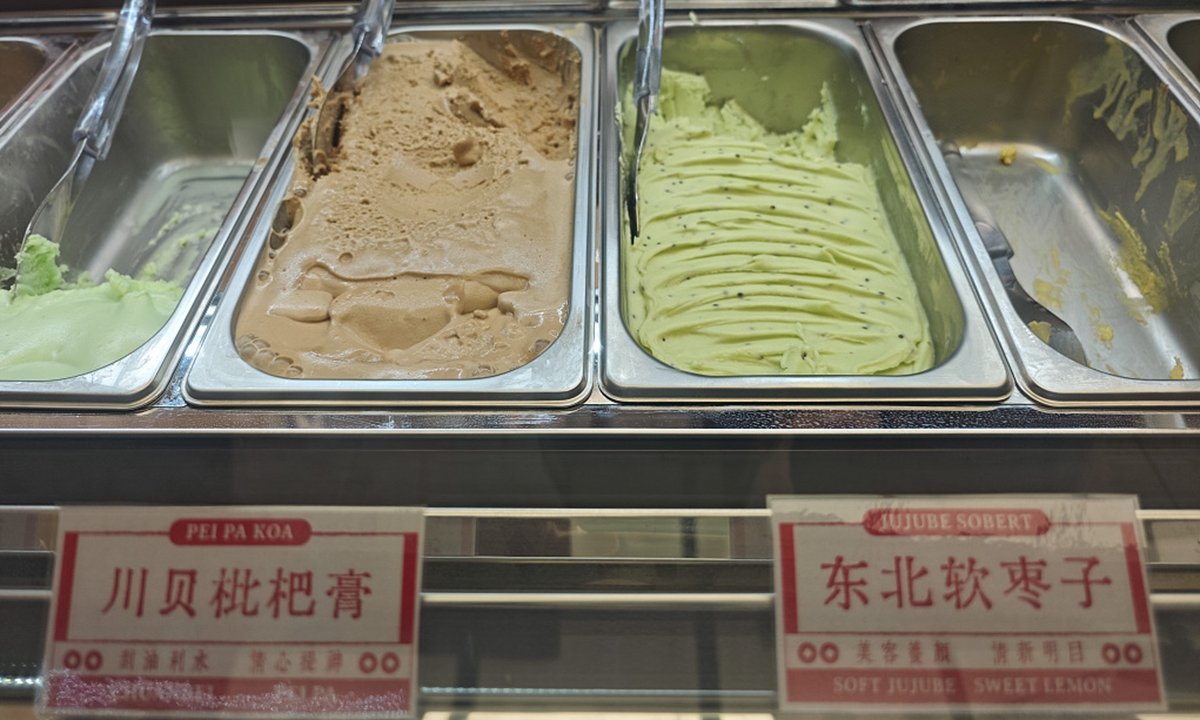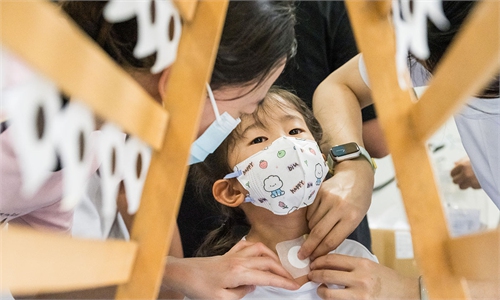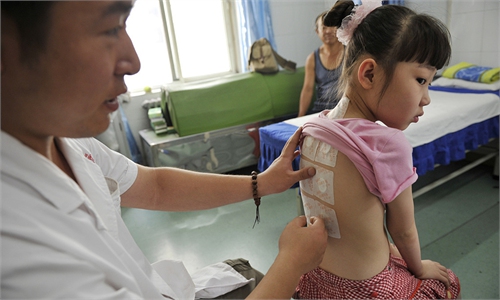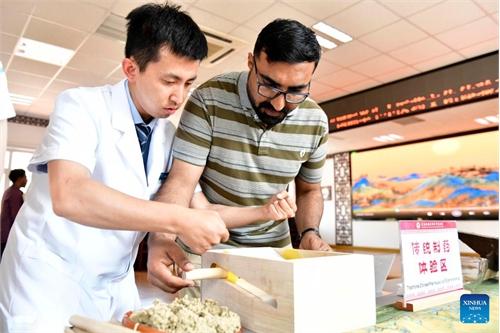ARTS / CULTURE & LEISURE
Rise of ‘TCM + food’: a trend fueled by health consciousness, cultural confidence
In Shanghai, a 38-yuan ($5.31) herbal ice cream has become a sensation. This novel ice cream incorporates various traditional Chinese medicine (TCM) herbs. The shop offers 16 different flavors, each infused with herbal elements and labeled with their purported benefits - such as "longan and red date rice milk" for calming the mind, and "ginseng jasmine lime tea" for boosting vitality.

In addition to adding TCM herbs to the ice cream itself, toppings also include TCM ingredients. For example, a portion of Changbai Mountain ginseng from Northeast China costs 12 yuan, and a portion of caterpillar fungus, an usually expensive ingredient in TCM, costs 18 yuan.
The staff said in an interview with the China News Service that these products primarily use ice cream as a base, with a small amount of herbal ingredients added to enhance the flavor. The concept is centered on the idea of "new Chinese-style herbs" and the traditional TCM principle that "food and medicine share the same origin."
This trend is part of a broader movement that has seen several TCM companies shifting toward more refined and immediate health products. Ingredients like panax, agastache, and chai ge are being creatively combined with modern consumables such as eye masks, teas, yogurts, ice creams, and coffee, drawing increasing consumer interest.
The popularity of this trend of integrating TCM into modern cuisine can be attributed to several factors, one of which is the belief "food and medicine share the same origin." This concept underpins the integration of medicinal herbs into everyday food items, offering a way for people to incorporate TCM principles into their daily lives subtly. However, it's essential to recognize that under China's Food Safety Law, only substances included in the official list of edible medicinal substances can be used as food ingredients.
Yi Lan, an attending TCM physician at a hospital in Guangzhou, told the Global Times that products that combine TCM and food typically use herbs that fall under this category, offering some health benefits. For instance, astragalus root is known to boost the immune system, and ophiopogon japonicus can nourish the lungs and calm the heart.
Yet, she noted, the efficacy of these products can vary depending on the type of herbs used, their dosage, the method of combination, and the consumer's individual constitution and health status. Thus, while these products can complement a healthy lifestyle, they should be consumed in moderation and under the guidance of a professional physician or nutritionist.
Moreover, it's crucial to remember that these products are not a substitute for medical treatment. Individuals with health concerns should seek prompt medical advice and adhere to prescribed treatments, she said.
The rapid rise of the "TCM+food" trend reflects today's growing public attention toward health, alongside a strong sense of cultural confidence. Over the past few years, the Chinese government has placed significant emphasis on the development of the TCM industry, introducing various policies and measures to support its innovation and growth. These initiatives have provided a solid foundation for the emergence of TCM-infused culinary products, Yi noted.
Meanwhile, for the "TCM+food" industry to sustain its upward trajectory, it must find a development path that truly reflects the unique characteristics of TCM, enhancing public knowledge.
The author is a reporter with the Global Times. life@globaltimes.com.cn

Chinese herbal flavored ice cream sells out at 2pm at an ice cream shop in the Xuhui district, Shanghai, on July 29, 2024. Photo: VCG
A dual-flavor serving (120 grams) was priced at 38 yuan, a triple-flavor option (150 grams) at 45 yuan, and a family-sized pack (500 grams) at 150 yuan. Additionally, the shop sells herbal teas at an average price of around 20 yuan.In addition to adding TCM herbs to the ice cream itself, toppings also include TCM ingredients. For example, a portion of Changbai Mountain ginseng from Northeast China costs 12 yuan, and a portion of caterpillar fungus, an usually expensive ingredient in TCM, costs 18 yuan.
The staff said in an interview with the China News Service that these products primarily use ice cream as a base, with a small amount of herbal ingredients added to enhance the flavor. The concept is centered on the idea of "new Chinese-style herbs" and the traditional TCM principle that "food and medicine share the same origin."
This trend is part of a broader movement that has seen several TCM companies shifting toward more refined and immediate health products. Ingredients like panax, agastache, and chai ge are being creatively combined with modern consumables such as eye masks, teas, yogurts, ice creams, and coffee, drawing increasing consumer interest.
The popularity of this trend of integrating TCM into modern cuisine can be attributed to several factors, one of which is the belief "food and medicine share the same origin." This concept underpins the integration of medicinal herbs into everyday food items, offering a way for people to incorporate TCM principles into their daily lives subtly. However, it's essential to recognize that under China's Food Safety Law, only substances included in the official list of edible medicinal substances can be used as food ingredients.
Yi Lan, an attending TCM physician at a hospital in Guangzhou, told the Global Times that products that combine TCM and food typically use herbs that fall under this category, offering some health benefits. For instance, astragalus root is known to boost the immune system, and ophiopogon japonicus can nourish the lungs and calm the heart.
Yet, she noted, the efficacy of these products can vary depending on the type of herbs used, their dosage, the method of combination, and the consumer's individual constitution and health status. Thus, while these products can complement a healthy lifestyle, they should be consumed in moderation and under the guidance of a professional physician or nutritionist.
Moreover, it's crucial to remember that these products are not a substitute for medical treatment. Individuals with health concerns should seek prompt medical advice and adhere to prescribed treatments, she said.
The rapid rise of the "TCM+food" trend reflects today's growing public attention toward health, alongside a strong sense of cultural confidence. Over the past few years, the Chinese government has placed significant emphasis on the development of the TCM industry, introducing various policies and measures to support its innovation and growth. These initiatives have provided a solid foundation for the emergence of TCM-infused culinary products, Yi noted.
Meanwhile, for the "TCM+food" industry to sustain its upward trajectory, it must find a development path that truly reflects the unique characteristics of TCM, enhancing public knowledge.
The author is a reporter with the Global Times. life@globaltimes.com.cn



